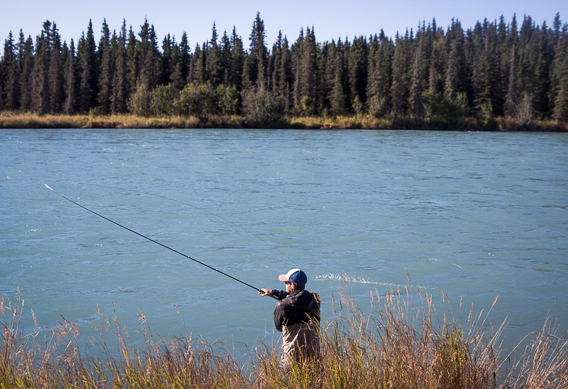Be mindful of your feelings.

When determining which Spey cast to use in a given situation, most experienced Spey anglers take into account three primary variables; wind direction (upstream wind, downstream wind, etc.), river position (which side of the river you’re casting from), and obstacles (trees, rocks, banks, or other obstructions that limit your casting area). The majority of the time, choosing your cast based on those three factors will result in a safe and fishable Spey cast.
However, there’s another variable that we find many anglers often neglect that is important to consider when determining which Spey cast to use.. Current speed!
The speed of the water from which you are casting (where your feet are, not where your fly lands) can play a big part in determining which cast to use. In extreme circumstances, casting from water that is either slower or faster than anticipated can create casting errors that can be frustrating to diagnose. You’ve done everything the same, the cast looked right, so what the heck happened!? There’s a good chance the current speed has changed.
Here are a few tips for keeping your casting game strong as the speed of the current changes.
- Poke Yourself Out of Trouble. The Perry Poke is arguably the most versatile Skagit-style Spey cast of all time. That being said, it’s important to note that the ‘poke’ motion can be combined with virtually any Spey cast to re-set the position of your anchor. This is extremely helpful when casting in difficult currents. For example, if forced to cast off your upstream side in a heavy current, it can be challenging to pull off a cast before the speed of the current has moved your anchor too close to your body in an unsafe position. However, in such currents, multiple pokes towards your target can help by your time and keep your anchor away from your body until you’re ready to go ahead with the forward cast. On the other hand, when casting in a current that is extremely slow, it can be difficult to keep your fly and/or sink tip from hanging up on the bottom before making the forward cast. Thus, incorporating an additional poke into the cast can help keep the fly and/or sink tip higher in the water column before making the forward cast.
- Current Speed Can Trump Wind Direction. When learning how to Spey cast, most are taught that the most important factor to consider before making a cast is the wind direction. This allows the caster to cast off the downwind side of their body, ensuring the fly cannot be blown into the caster’s body, face, etc. Safety should always be the primary concern, thus casting off the downwind side whenever possible is extremely important. That being said, there are instances where speedy currents can push your anchor (and thus leader and fly) closer to an unsafe position than a soft breeze might. Thus, before choosing your cast off the wind direction alone, also consider the speed of the current as a heavy current could justify casting off the windward side on a relatively calm day.
- Anticipate Your Anchor. Fundamentally speaking, most S casters know that your ‘anchor’ should land approximately a rod tip away, at a 45-degree angle either upstream or downstream of your position depending on the cast. However, that goes out the window when Spey casting in heavy current. Why? Because it’s not where your anchor lands that matters, it’s where it’s positioned when it comes time to make the forward cast. Thus, if casting in a fast current, anticipating the effects of the speed of the water by placing your anchor slightly further upstream can result in better anchor placement for more efficient and safer casts.
- Floating Running Lines Can Help. We love mono running lines on our Spey rods. That being said, most mono running lines also don’t float, which can pose challenges when casting in difficult current speeds, especially faster currents. Mono that has been pulled under the surface in faster water can be difficult to ‘dig’ out on the forward cast, potentially compromising distance. We’re not planning on tossing our mono lines just yet, but if you’re planning on fishing in swifter currents the majority of the time (ahem, Nakek anyone?), you might consider a floating running line option instead.
- When in Doubt, Bail. As we mentioned above, safety should be the utmost concern before making a cast. If there’s ever a question as to whether any part of your cast will produce an unsafe result, it’s always best to abort the cast, roll your fly, back downstream, and try again. Remember, the time required to fish through a bad cast, pick out a casting knot, or dig a fly out of your ear is far more than simply flipping your fly, back downstream and making another cast.
Leave a Reply